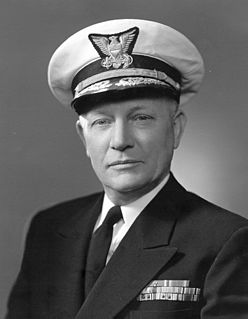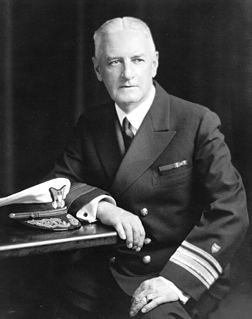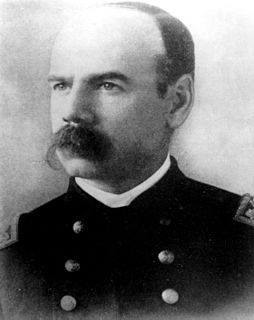
Frank Hamilton Newcomb was a United States Revenue Cutter Service commodore, best known for his actions at the Battle of Cárdenas during the Spanish–American War.

Elmer "Archie" Fowler Stone was a United States naval aviator and a commander in the United States Coast Guard.

The first USS Fanning (DD-37) was a modified Paulding-class destroyer in the United States Navy during World War I and later in the United States Coast Guard, designated as CG-11. Her namesake was Nathaniel Fanning.

Merlin O'Neill served as the tenth Commandant of the United States Coast Guard from 1 January 1950 to 1 June 1954.

Joseph Francis Farley served as the ninth Commandant of the United States Coast Guard from 1946 to 1949. He was also the first Coast Guard officer to be issued a service number and held #1000 on the Coast Guard officer rolls.

Russell Randolph Waesche, Sr. served as the eighth Commandant of the United States Coast Guard from 1936 to 1946, overseeing the service during World War II. He was the U.S. Coast Guard's longest serving commandant, having served ten years in that post. In addition, he was the first officer to hold the ranks of vice admiral and admiral within the Coast Guard.

Harry Gabriel Hamlet was the seventh Commandant of the United States Coast Guard, from 1932 to 1936.

William Edward Reynolds served as the fifth Commandant of the United States Coast Guard, from 1919 to 1924.

John Herbert "Babe" Brown, Jr. was a decorated officer in the United States Navy with the rank of Vice admiral during World War II and an American football player. A graduate of the United States Naval Academy, Brown trained as submariner and served successively as Commander, Submarine Squadron 4 and Commander Training Command, Submarine Force, Pacific Fleet in the opening years of World War II. Brown was then promoted to Rear admiral and commanded Cruiser Division One during the bombardment of Japan in summer 1945.

Edward Hanson "Iceberg" Smith was a United States Coast Guard admiral, oceanographer, and Arctic explorer. He was born 29 October 1889 at Vineyard Haven, Massachusetts. He received a Ph.D. in oceanography from Harvard, and commanded the USCGC Marion and the USCGC Northland. Most famously, he commanded the Greenland Patrol, and led Coast Guard efforts to defend Greenland against the Germans in World War II. After retirement from the Coast Guard, he assumed the directorship of Woods Hole Oceanographic Institution.

Worth G. Ross is known as the third Commandant of the Coast Guard, although he was never formally appointed to that position. Joining the United States Revenue Cutter Service in 1877, he graduated from the Revenue Cutter Service School of Instruction's first class in 1879. He held a variety of appointments during the late 19th century before being appointed Captain-Commandant of the service in 1905. In this capacity he commanded a number of cutters on the United States Gulf Coast and was responsible for moving the School of Instruction to Fort Trumbull, Connecticut. He was a relation of Brevet Brigadier General Samuel Ross (1822-1880), who commanded the 20th Connecticut Infantry during the American Civil War.

Leonard G. Shepard, was a captain in the United States Revenue Cutter Service and was appointed in 1889 by Secretary of the Treasury William Windom as the first military head of the service since 1869. His formal title was that of Chief of the Revenue Marine Division of the Department of the Treasury. Although he was never formally known as Commandant, he is recognized today as the first Commandant of the Coast Guard.

Ronald James Rábago is a retired United States Coast Guard rear admiral who in 2006 became the first person of Hispanic American descent to be promoted to flag rank in the United States Coast Guard. He retired as the assistant commandant for engineering and logistics and the United States Coast Guard's chief engineer in 2014.

USRC Onondaga was an Algonquin-class cutter built for the U.S. Revenue Cutter Service for service on the Great Lakes. Because of the Spanish–American War, she was cut in half shortly before completion and transported to Ogdensburg, New York for service on the Atlantic coast although the war ended before she could be put into service. After the formation of the United States Coast Guard in 1915 she became USCGC Onondaga. She served as a patrol vessel at various Atlantic coast ports before World War I and unlike most Coast Guard cutters during World War I, she remained under the control of the Commandant of the Coast Guard. After the war she patrolled for a brief time based at New London, Connecticut before being decommissioned in 1923.

James Angus Watson IV is a retired United States Coast Guard Rear Admiral. He currently serves as a Senior Vice President at the American Bureau of Shipping.
Hispanics and Latinos in the United States Coast Guard can trace their tradition of service to the early 19th century, when they initially performed duties at light house stations as keepers and assistant keepers in its predecessor services. Hispanic is an ethnic term employed to categorize any citizen or resident of the United States, of any racial background, of any country, and of any religion, who has at least one ancestor from the people of Spain or is of non-Hispanic origin, but has an ancestor from Mexico, Puerto Rico, Cuba, Central or South America, or some other Hispanic origin. The three largest Hispanic groups in the United States are the Mexican-Americans, Puerto Ricans, and Cubans.

Rear Admiral Spencer Shepard Wood was a United States Navy officer. His career included service in the Spanish–American War and World War I, command of battleships and cruisers, and duty as an aide to a number of senior naval leaders.
Leon Claude Covell was a Rear Admiral in the United States Coast Guard who served as the 2nd Vice Commandant from 1931 to 1941.

Norman Brierley Hall was an engineering officer in the United States Coast Guard who became the first aviation engineer in the Coast Guard in 1916.
















